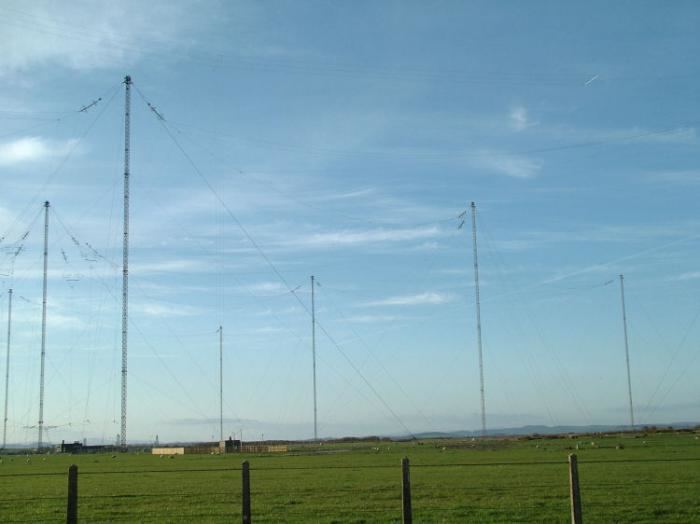Grid reference NY179581 | Mast height 227 metres (745 ft) | |
 | ||
Similar Allouis longwave transmitter, VLF transmitter DHO38, St Martin's Church - Brampton, St Patrick's Church - Preston P, Great Langdale | ||
Anthorn Radio Station is located near Anthorn, Cumbria, England, overlooking the Solway Firth, and is operated by Babcock International (with whom former operators VT Communications are now merged). It has three transmitters: one VLF; one LF; and an eLORAN transmitter.
Contents
- RNAS Anthorn
- Operational Units
- VLF transmitter
- LF transmitter National Physical Laboratory time signal
- LORAN
- Antenna system
- References
The characteristic triangular pattern of roads is a remnant from the World War II military airfield which was operated by the Royal Navy Air Service as HMS Nuthatch.
RNAS Anthorn
John Laing & Son began building an airfield at Anthorn for the Fleet Air Arm in late 1943, with Royal Naval Air Station Anthorn, or HMS Nuthatch opening on 7 September 1944, with three tarmac runways. It was the base of No. 1 Aircraft Receipt and Despatch Unit (No. 1 ARDU), which had the job of receiving aircraft fresh from manufacturers, modifying them to Service standards and despatching them to operational squadrons, with the unit specialising in the Vought F4U Corsair. No. 1 ARDU continued to operate from Anthorn following the end of the Second World War, while a number of Fleet Air Arm Squadrons were also based at the airfield in the immediate post war years. The airbase shut down in March 1958.
Operational Units
Source:
VLF transmitter
The VLF transmitter is used primarily for transmitting orders to submarines on 19.6 kHz. Its callsign is GQD. VLF transmissions are relatively unaffected by atmospheric nuclear explosions and Anthorn was once part of the link between Fylingdales early warning radar, North Yorkshire, and the United States' air defence system.
It is a NATO facility, controlled from Northwood Headquarters along with three other VLF transmitters in Norway, Germany and Italy. In accordance with the procedure for NATO projects, the project was the subject of a competition among the organisation's member countries. The British Post Office, acting as technical adviser and agent of the Ministry of Defence, chose the site, negotiated the contract and supervised the work, with the assistance of the Ministry of Public Building and Works. The contract was placed on 26 October 1961 with Continental Electronics Systems Incorporated of Dallas, Texas. This firm had already built a similar but much larger station in Maine, USA. Work began in 1962 and the station was accepted on behalf of the MoD in November 1964.
Originally, the station was designed to radiate a single telegraph channel at up to 45.5 baud and at powers ranging from 50 kW at 16 kHz to 100 kW at 20 kHz. The carrier frequency was to be stable to one part in 108 over a month. Subsequently the data rate was increased to 50 baud and the carrier stability improved.
LF transmitter: National Physical Laboratory time signal
The National Physical Laboratory (NPL) has installed three atomic clocks at Anthorn and on 27 February 2007 Britain’s national time signal transmissions, retaining their original call sign of MSF, were transferred there on a trial basis, moving formally on 1 April 2007. Monitoring and logging of the clocks and control of the transmissions is by Internet link from the NPL offices at Teddington, using comparison with GPS signals at both locations. Signal monitoring is by radio. To ensure accuracy, dynamic adjustment of the aerial according to local conditions (such as wind distortion) is controlled from computers on site. The signals, transmitted at 60 kHz, also provide a national frequency standard. The effective radiated power is 17 kW.
LORAN
The General Lighthouse Authorities for Britain and Ireland have contracted VT Communications to develop eLORAN (enhanced LORAN) radio navigational aid for mariners. The transmitter is at Anthorn.
Antenna system
The antenna system consists of thirteen masts, each 227 metres (745 ft) tall, which are arranged in two rings around the central mast. The VLF antenna consists of four rhombic antennas hung on large insulators on the masts, which are all grounded.
The LF antenna is a T-antenna spun between two masts.
